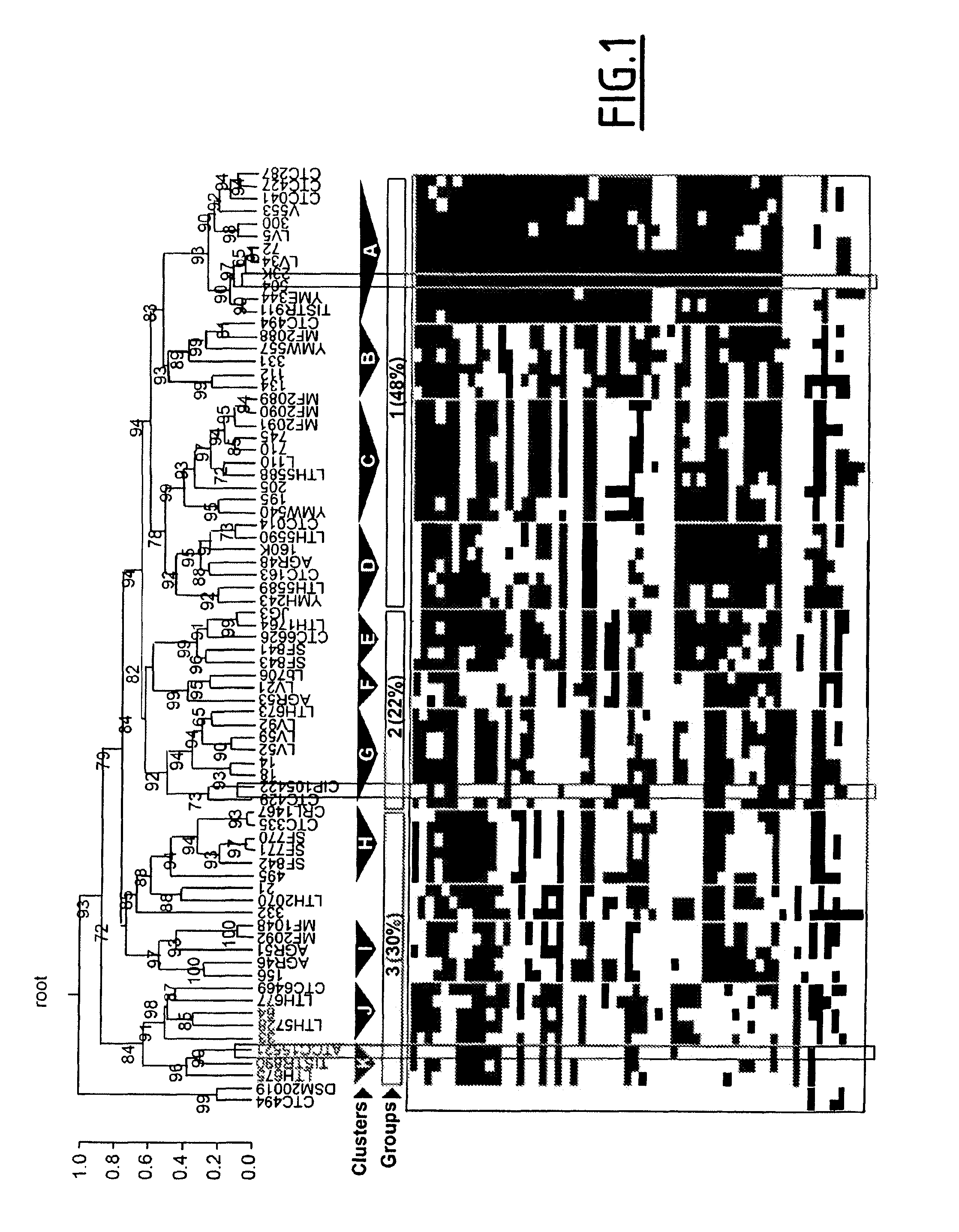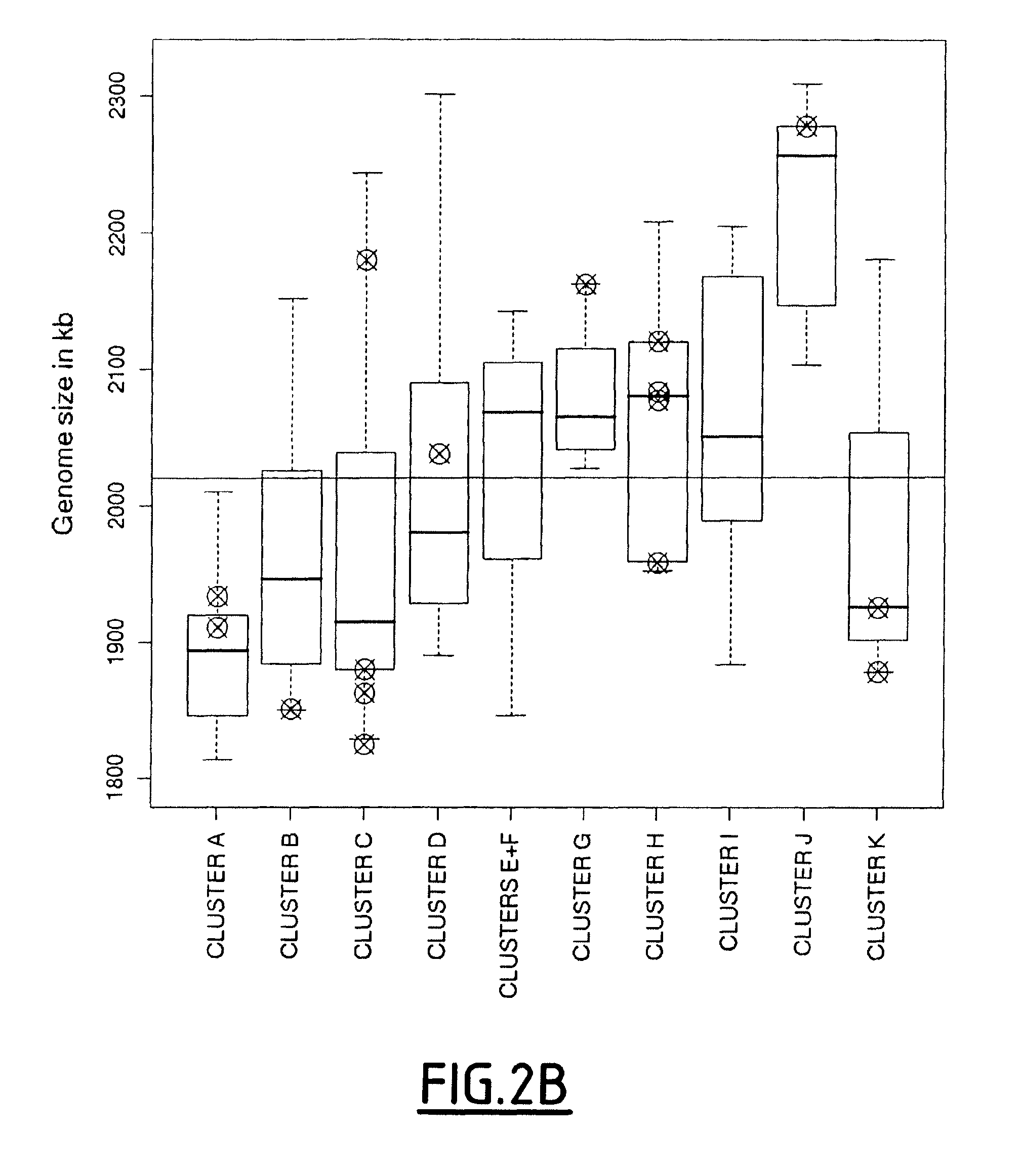Combination of marker genes for characterizing a Lactobacillus sakei strain
a technology of lactobacillus sakei and marker genes, which is applied in the field of conjugation of marker genes for characterizing a lactobacillus sakei strain, can solve the problems of unsatisfactory strain classification obtained through these approaches, unavoidable microbial contamination of processing environment, and difficult classification
- Summary
- Abstract
- Description
- Claims
- Application Information
AI Technical Summary
Benefits of technology
Problems solved by technology
Method used
Image
Examples
example 1
Detection and Analysis of Genomic Islands in Lactobacillus sakei 23K Chromosome
[0137]This example describes the identification by the inventors of genomic islands in L. sakei 23K chromosome, which carry the genes used as markers in the present invention.
[0138]It is admitted that bacterial chromosomes are divided into two sets of genes: the core gene pool, that comprises genes that persisted in the species for long enough to show maintenance among strains, and the flexible gene pool, that comprises variable and auxiliary genes generally clustered in islands and often acquired by horizontal gene transfer (HGT).
[0139]The aim of the present study is therefore to identify the putative variable genomic islands in the genome of L. sakei 23K and to characterize the cellular functions, estimated to be ecologically important, that could be ascribed to HGT.
Experimental Procedures
Codon Usage Analysis
[0140]The codon usage signature of highly expressed genes was searched by using the CAI introduc...
example 2
Intra-Species Genomic Diversity and Natural Population Structure of the Meat-Borne Lactic Acid Bacterium Lactobacillus sakei
[0150]This example describes the classification, by the inventors, of L. sakei strains using marker genes.
[0151]In this study, the inventors have performed a combination of several typing techniques including pulse-field gel electrophoresis (PFGE) genome mapping, PCR-based detection of genetic markers taken from a pool of variable genes identified by the inventors (see example 1) for hierarchical clustering of the strains, and finally, a proteomic comparison to evaluate their respective phenotypic diversity. Isolates from diverse laboratory collections corresponding to various geographical locations and to various sources of meat- or fish-related products have been specifically chosen, based on the expectation that these undomesticated strains would represent the diversity of the natural L. sakei population.
[0152]These results provide an integrated genomic-bas...
example 3
[0181]In this example, the inventors have performed a PCR-based detection of 29 genetic markers taken from a pool of variable genes for hierarchical clustering of the strains.
[0182]All of the L. sakei and L. curvatus strains used in this study are described in Table 2.
[0183]The gene contents of the strains tested were described by using a two-character matrix (genes×isolates) with 0 for absence and 1 for presence of a gene. Similarities between the strains were determined using the Jaccard's correlation coefficient (or Jaccard index) as defined above.
[0184]A screening similar to the one described in example 2 was performed by the inventors, and resulted in the selection of only 29 marker genes summarized in Table 1.
[0185]Based on the PCR analysis of these only 29 genes, the inventors classified the L. sakei natural isolates by using unsupervised complete-linkage hierarchical clustering algorithm and by estimating P-values via multiscale bootstrap resampling to assess the uncertainty...
PUM
| Property | Measurement | Unit |
|---|---|---|
| pH | aaaaa | aaaaa |
| pH | aaaaa | aaaaa |
| binary distance | aaaaa | aaaaa |
Abstract
Description
Claims
Application Information
 Login to View More
Login to View More - R&D
- Intellectual Property
- Life Sciences
- Materials
- Tech Scout
- Unparalleled Data Quality
- Higher Quality Content
- 60% Fewer Hallucinations
Browse by: Latest US Patents, China's latest patents, Technical Efficacy Thesaurus, Application Domain, Technology Topic, Popular Technical Reports.
© 2025 PatSnap. All rights reserved.Legal|Privacy policy|Modern Slavery Act Transparency Statement|Sitemap|About US| Contact US: help@patsnap.com



